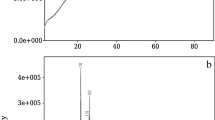Conclusions
The greatest wear of magnesite-chrome and periclase-spinel linings was observed in the cylindrical part of the converter in the places showing intense movement of metal and slag and maximum heat load. In these sections of the structure we get a predominant erosion by fusion, but the share of the erosion due to scaling is substantial.
In the throat, wear of the lining occurs mainly due to scaling as a result of frequent changes in temperature and air.
The wear of the lining of the bottom is slight compared with sections located above and takes place mainly as a result of erosion developed during intensive movement of the metal in the blow period.
PS refractories are more resistant in the linings of the converter than MC refractories, which is explained by the difference in the mechanism of their wear.
To increase the resistance of refractories PS against the action of converter slags it is necessary to make them from enriched chromitic ores and magnesite with the use of high-temperature firing, which will ensure better development of the direct bond of the grains of periclase with the chrome-spinel and more complete mineral formation (with maximum yield of secondary spinel).
Similar content being viewed by others
Literature cited
E. V. Ivanov, et al., Collection of papers UNIIO, No. 5 (1961).
G. N. Kozin, et al., Ogneupory No. 2, p. 71 (1963).
A. P. Kudrina, et al., Stal' No. 9, p. 400 (1963).
G. V. Golov, et al., Stal' No. 6 (1965).
Refractories for Producting Steel Using Oxygen Symposium From English, Metallurgiya, [in Russian] (1965).
G. V. Sokolov, Collections “Chromates USSR”, Vol.II, Acad., Sci., USSR, [in Russian] (1940).
S. M. Zubakov, Mineral Formation in Chrome-Magnesite Refractories, Acad. Sci. KazSSR (1960).
L. J. Trostel, J. Amer. Ceram. Soc., Vol. 22, No. 2 (1939).
A. S. Frenkel', et al., Collection of papers, UNIIO, No. 3, [in Russian] (1960).
L. I. Karyakin and K. N. Repenko, Trans 5th Conference on Experimental and Industrial Mineralogy and Petrography, Acad. Sci. USSR, [in Russian] (1958).
W. S. Treffner, J. Amer. Ceram. Soc., Vol. 45, No. 10 (1962).
W. S. Treffner, J. Amer. Ceram. Soc., Vol. 44, No. 12 (1961).
G. R. Rigby, Trans. Brit. Ceram. Soc., Vol. 55, No. 1 (1956).
A. D. Smiegelskas and E. O. Kirkendall, Trans. Amer. Inst. min. Eng.,171, 130 (1947).
Author information
Authors and Affiliations
Additional information
Translated from Ogneupory, No. 1, pp.32–38, January, 1967.
Rights and permissions
About this article
Cite this article
Simonov, K.V., Perepelitsyn, V.A., Golov, G.V. et al. Destructive mechanism for periclase-spinel and magnesite-chromite refractories in oxygen converter linings. Refractories 8, 33–40 (1967). https://doi.org/10.1007/BF01290208
Issue Date:
DOI: https://doi.org/10.1007/BF01290208




